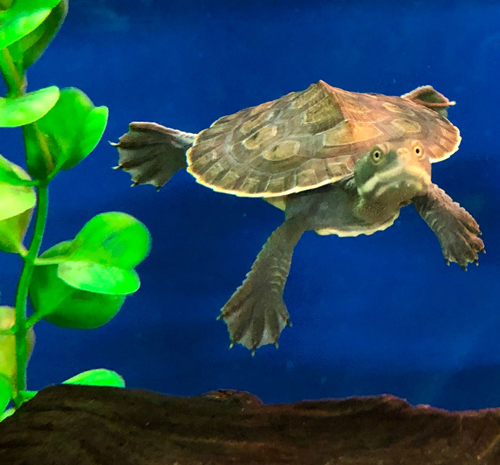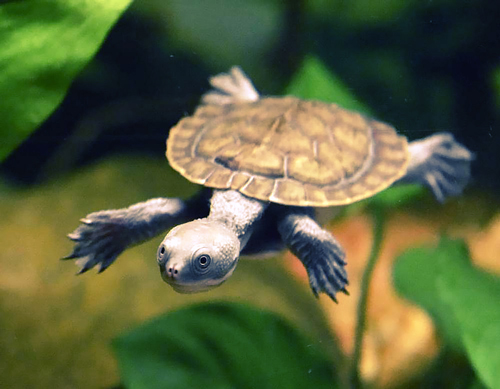Keeping Pet Turtles

Often misunderstood, turtles grow very large and have long life spans. Native Australian turtles require a lot of room, no fish tank will be suitable for these guys. You'll eventually need to upgrade to a 6 foot turtle specific tank or outdoor pond to house them at their full size.
Pet turtles have been around for a while, but our understanding of them has changed dramatically over this time. Media has given these guys a bad run, often resulting in improper husbandry and health problems. Native Australian turtles require a lot of room, no fish tank will be suitable for these guys. You'll eventually need to upgrade to a 6 foot turtle specific tank or outdoor pond to house them at their full size.
Quick Links
Quick Facts

Turtles can live for well over 25 years
There have even been cases of turtles living well past 25 years of age.

Penny Turtles Don't Exist
It's a term used to describe baby turtles. Their shell will still grow to 20-30cm wide.

They Need a 6 Ft Tank or Pond
Most species require a 6 ft (180cm) tank, or a pond. Bigger is always better.

UVA & UVB is Required
Like most reptiles, they need a source of UV heat and light.

Water Heating & Care
Their water requires maintenance and heating just like a tropical fish aquarium
Housing Basics for a Pet Turtle
Enclosure Size Recommendations
Baby Turtles:
120 x 60 x 60cm
Adult Turtles:
180 x 60 x 60cm or Pond
What Size Tank Does A Turtle Need?
For babies, it's a good idea to buy as large of a tank as you can manage so you won't need to upgrade as soon.. A good size to begin with is 120x60x60cm, but as adults 180x60x60 is more suitable. Tanks smaller than 90cm in length are not suitable for turtles.
The water depth must be at least 2-3 times the length of the shell at a minimum.
Are Turtles For Sale?
Give Pet City Mt Gravatt a call on 07 3349 2086 to see if we have any turtles in-store. We also sell all the equipment in-store to make sure you are prepared to own a pet turtle. It is important that you have acquired a turtle license before trying to take one home with you.
Shop Turtle TanksPonds
Adults would ideally be housed in a suitable, escape-proof outdoor pond. It is usually a good idea to wait until the turtle has a shell diameter of approximately 15cm before housing in an outdoor pond. If this is not possible, then a 6ft tank is suitable for most species but larger is always better.
Plant Cover
Most turtles are quite timid. At least one third of the tank should be densely planted to provide cover. Driftwood can also be incorporated into the aquascape for additional hiding areas and enrichment. Care must be taken when placing furnishings to ensure that the turtle cannot become wedged or pinned underwater, otherwise drowning can occur.
Turtle Docks
A turtle dock is essential to provide a basking area for your turtle. The dock must be large enough for the turtle to fit its entire body. It is essential that the UVB and heat lamp are both positioned over the dock. Keep in mind that plastic and glass filter out all UVB so it is paramount that there isn’t any glass or plastic between your bulbs and the turtle's basking area.
Can I Keep More Than One Turtle In A Tank?
Keeping more than one short-necked turtle in a tank is not recommended as they are solitary animals and can cause serious stress and injury to one another.
Eastern long-necks can however be housed together providing they are about the same size and the size of the tank is appropriate (180x60x60cm). Always monitor the behaviour of your turtles and ensure they are both receiving the same amount of food, as often one may bully the other and steal their food.

What Turtle Species Can Be Kept As Pets?
There are 4x main species of Australian turtle you can keep under a Native Animal Keeping Licence. These are:
- Kreft’s Turtle (Emydura kreftii)
- Murray River Turtle (Emydura macquarii)
- Saw-shelled Turtle (Elesya latisternum)
- Long-necked Turtle (Chelodonia longicollis)
Penny Turtles
There is no such thing as a penny turtle. This is a term given to baby turtles as they are usually the size of a penny. Most Australian turtle species grow to about the size of a dinner plate, or with a shell diameter of 20-30cm.
Water Care & Maintenance
Short Necked Species
25°C
Long Necked Species
22°C
pH
7.2-7.6
The temperature of the water is dependent on species, but short-necks are generally best kept at 25 degrees and long-necks at 22 degrees. This means that a water heater may be needed during winter and a chiller may be required in summer to maintain these temperatures. Turtles are extremely messy creatures so an external canister filter is essential to help maintain water quality, in addition to 20-25% weekly water changes.
Turtles spend the majority of their time in the water so it is extremely important to conduct weekly water tests for ammonia, nitrite, nitrate, pH and hardness. A pH of 7.2-7.6 is ideal and a water hardness of 140-210ppm is recommended – this can usually be achieved by adding approximately 4g of aquarium salt per litre of water but water testing is still required.
Heating and Lighting for Pet Turtles
Turtles require both a white basking lamp as well as a UVB lamp, and both of these should be positioned over the turtle dock which becomes the Basking Zone. The temperature of the basking zone should be 30-34 degrees and it is always recommended to control and monitor this temperature via a thermostat and digital thermometer.
Pet City recommends a 5% UVB tube when positioned approximately 20cm above the dock and this lamp needs to be replaced every 6 months.
Taking your Turtle Outdoors for Natural Light
Taking your turtle outside for no more than 20-30 minutes at a time, 2-3 times per week can have great health benefits but this is not recommended for hatchling turtles as it can be too stressful. Always make sure “outside time” is fully supervised and that the turtle also has access to shade.
What Do Turtles Eat?
Turtles are scavengers in the wild and will feast on a large variety of foods. You should be adjusting the type of diet according to what species you have and their age, but ultimately variety is of the utmost importance.
Short-necked turtles are omnivorous, and as juveniles they require more protein in their diet than adults. Long-necked turtles are carnivorous. The diet should include fresh whole foods such as shrimp, fish, mussels, insects (e.g. black soldier fly larvae, crickets, silkworms) in addition to pellets. Frozen “turtle dinners” can also be used providing they are used as part of a varied diet. Suitable aquarium plants such as Elodea and Thin Vallisneria should always be on offer and any uneaten food should be removed to prevent waste build up. A calcium supplement is also recommended, especially if your turtle is not consuming whole prey.
Due to a turtle's scavenging nature, they will continuously consume food even when they are not hungry. It is vital to portion your turtles food to ensure they don't over eat and become overweight. They have a tendency to always act ravenous at feeding time, and this is just a normal part of their behaviour.
How Much Should I Feed A Turtle?
The following recommendations should be used as a guide only. The amount of food offered should be about the size of the turtles’ head.
Recommended Frequency of feeding:
Hatchlings
small amounts of food daily
Juveniles
Every second day
Adults
Once or twice a week

What Substrate Is Best for a Turtle?
Large river stones or fine river sand approximately 5cm in depth can be used. Gravel should never be used as turtles can accidentally ingest it which can result in a trip to the vet.
- Large River Stones
- Fine River Sand
- Turtle Docks can also be useful in your tank
How to Handle your Turtle
Aside from checking weight, we do not recommend handling your turtle until your turtle’s shell is approximately 10cm in diameter. Handling should be introduced very slowly and for short periods at a time. Turtles aren’t a pet that you should let wander around your house, as they are predominantly aquatic and this can cause stress. Any time out of the tank should also be of benefit to the turtle e.g. taking it outside under supervision for natural sunlight.
Applying for a Native Animal Keeping Licence in Queensland
A Native Animal Keeping Licence is required for having any pet turtle. Please check with your state government website, for Queensland, please click the link below.
Apply for a Licence (QLD)
Other Considerations
- Annual health checks are recommended at a veterinary clinic experienced with reptiles.
- Always make sure to wash your hands thoroughly after handling your turtle.
- It is good practice to keep a record of your turtle’s weights and feeding habits, especially juveniles.








